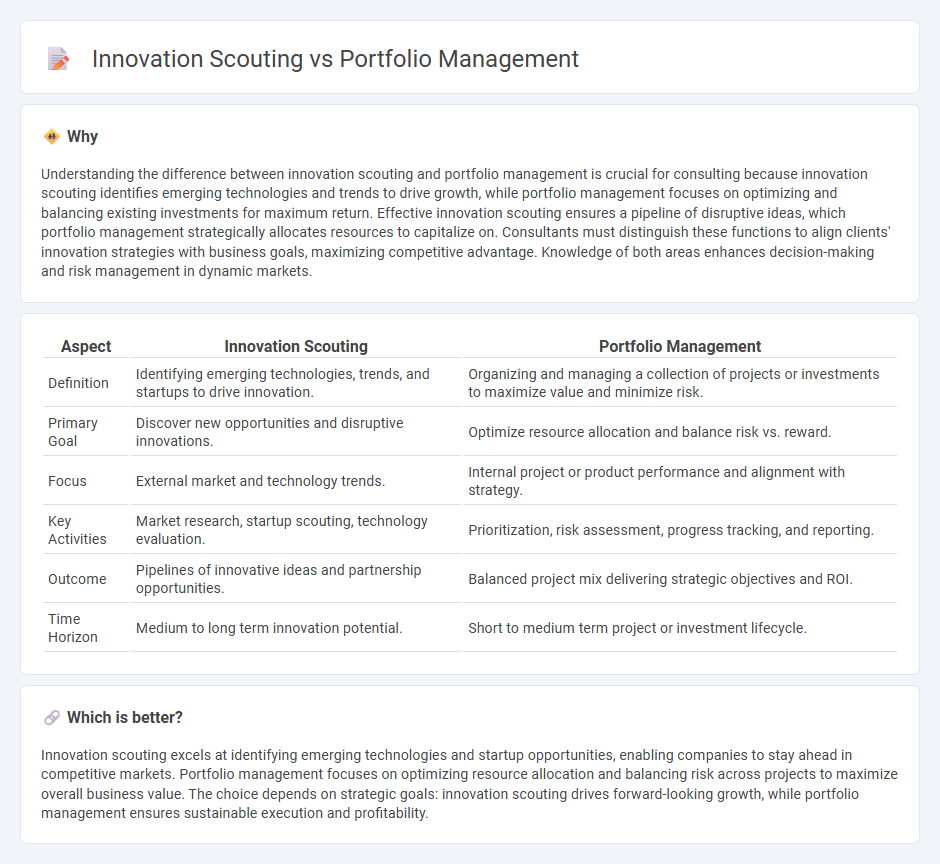
Innovation scouting identifies emerging technologies and startups to drive growth and competitive advantage, focusing on external opportunities and trends. Portfolio management optimizes existing projects and investments, balancing risk and return to align with strategic business objectives. Explore how combining innovation scouting with portfolio management can enhance your organization's innovation strategy.
Why it is important
Understanding the difference between innovation scouting and portfolio management is crucial for consulting because innovation scouting identifies emerging technologies and trends to drive growth, while portfolio management focuses on optimizing and balancing existing investments for maximum return. Effective innovation scouting ensures a pipeline of disruptive ideas, which portfolio management strategically allocates resources to capitalize on. Consultants must distinguish these functions to align clients' innovation strategies with business goals, maximizing competitive advantage. Knowledge of both areas enhances decision-making and risk management in dynamic markets.
Comparison Table
| Aspect | Innovation Scouting | Portfolio Management |
|---|---|---|
| Definition | Identifying emerging technologies, trends, and startups to drive innovation. | Organizing and managing a collection of projects or investments to maximize value and minimize risk. |
| Primary Goal | Discover new opportunities and disruptive innovations. | Optimize resource allocation and balance risk vs. reward. |
| Focus | External market and technology trends. | Internal project or product performance and alignment with strategy. |
| Key Activities | Market research, startup scouting, technology evaluation. | Prioritization, risk assessment, progress tracking, and reporting. |
| Outcome | Pipelines of innovative ideas and partnership opportunities. | Balanced project mix delivering strategic objectives and ROI. |
| Time Horizon | Medium to long term innovation potential. | Short to medium term project or investment lifecycle. |
Which is better?
Innovation scouting excels at identifying emerging technologies and startup opportunities, enabling companies to stay ahead in competitive markets. Portfolio management focuses on optimizing resource allocation and balancing risk across projects to maximize overall business value. The choice depends on strategic goals: innovation scouting drives forward-looking growth, while portfolio management ensures sustainable execution and profitability.
Connection
Innovation scouting identifies emerging technologies and market trends that feed into portfolio management decisions, ensuring a dynamic and competitive project mix. By continuously sourcing novel ideas and evaluating their potential, consulting firms can optimize resource allocation and prioritize initiatives with highest strategic value. This integrated approach enhances agility and drives sustainable growth within client organizations.
Key Terms
**Portfolio management:**
Portfolio management involves the strategic selection, prioritization, and monitoring of projects or investments to maximize value and align with organizational goals. It emphasizes balancing risk and return across diverse assets while optimizing resource allocation for long-term growth and profitability. Discover more about how effective portfolio management drives sustainable business success.
Resource Allocation
Portfolio management strategically allocates resources across projects and investments to maximize returns and balance risk, employing data-driven analysis and financial metrics. Innovation scouting identifies emerging technologies and startups, directing attention and limited resources toward potentially disruptive opportunities that align with long-term strategic goals. Explore how integrating both approaches can optimize resource allocation and drive sustainable growth.
Risk Assessment
Portfolio management systematically evaluates and mitigates risks across a range of projects to optimize resource allocation and ensure strategic alignment with business goals. Innovation scouting emphasizes identifying emerging technologies and trends, prioritizing potential high-impact innovations while assessing uncertainties related to market adoption and technological feasibility. Explore deeper insights to effectively balance risk assessment in portfolio management and innovation scouting strategies.
Source and External Links
An Introduction to Portfolio Management - Portfolio management involves allocating across asset classes, selecting individual assets, executing trades, and evaluating performance to maximize returns given risk preferences.
Portfolio management: What it is and how to do it - Vanguard - It is the process of creating and managing investments by setting goals, determining asset allocation, and choosing diversified investments aligned with risk tolerance.
Portfolio Management Practices - Portfolio management in a business context includes identifying value opportunities, planning resources, prioritizing projects, addressing risks, and governance to manage investments effectively.
 dowidth.com
dowidth.com